In the 1950s, during just four years Cobb Park (see Part 1) on the East Side was transformed by four new facilities in the park’s northern end. The new facilities were concentrated in an area of just one-tenth of a square mile, a small fraction of the park’s 224 acres, but these facilities gave the park a structure it had lacked and redefined the nature of the park for a quarter of a century.
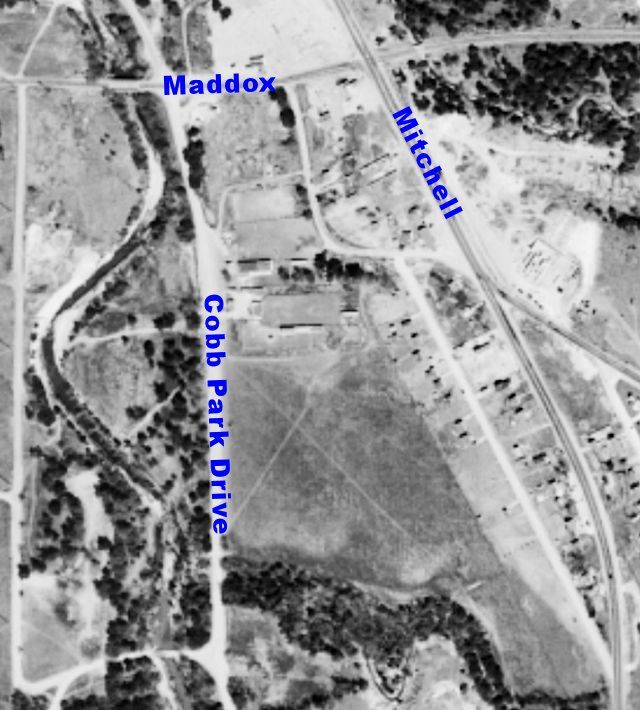 Here is that one-tenth-square-mile area in 1952, stretching from Maddox Avenue south to U.S. 287 and from Burchill Road west to Sycamore Creek.
Here is that one-tenth-square-mile area in 1952, stretching from Maddox Avenue south to U.S. 287 and from Burchill Road west to Sycamore Creek.
 By 1959 that one-tenth-square-mile area would have these four additions.
By 1959 that one-tenth-square-mile area would have these four additions.
1955
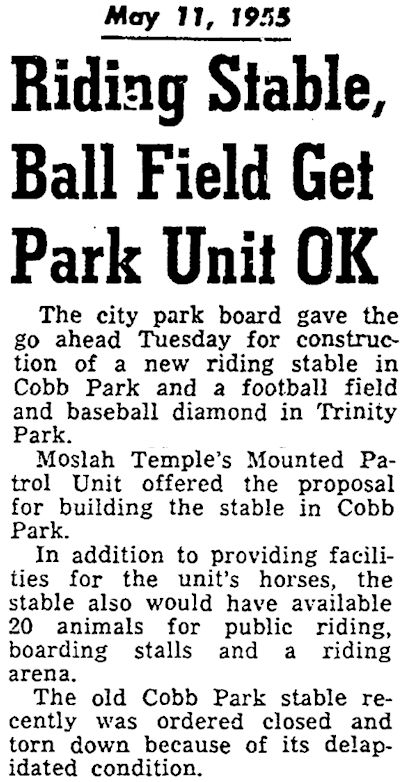 In 1955 a new riding stable and arena were the first of the four additions. The Moslah Temple Patrol Unit offered to build the facility for its own and public use.
In 1955 a new riding stable and arena were the first of the four additions. The Moslah Temple Patrol Unit offered to build the facility for its own and public use.
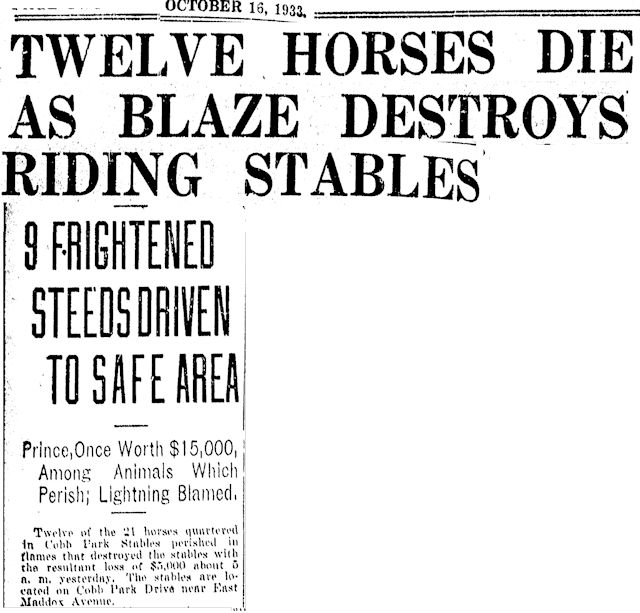 A. B. Post had opened a riding stable and arena in the park in 1931. In 1933 twelve horses were killed in a fire at the stable. The original stable was located across Cobb Park Drive from the new stable. Its oval outline can be seen in the 1952 aerial photo.
A. B. Post had opened a riding stable and arena in the park in 1931. In 1933 twelve horses were killed in a fire at the stable. The original stable was located across Cobb Park Drive from the new stable. Its oval outline can be seen in the 1952 aerial photo.
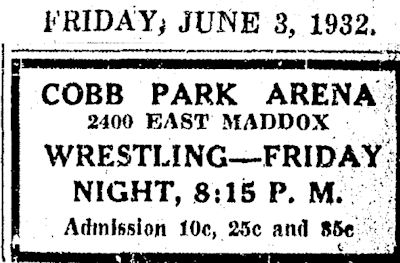 Most of the time the original arena was occupied by trotting mares, but occasionally it was occupied by flying mares: In 1932 wrestling matches were held in the arena. Boxing matches also were held in the arena. A. B. Post also sold used cars at the arena. Oh, and milk cows. (East Side native Dan Washmon points out that Aylmer Bluford Post, who would later concentrate on auto sales, was the father of former Arlington Pontiac dealer Buz Post.)
Most of the time the original arena was occupied by trotting mares, but occasionally it was occupied by flying mares: In 1932 wrestling matches were held in the arena. Boxing matches also were held in the arena. A. B. Post also sold used cars at the arena. Oh, and milk cows. (East Side native Dan Washmon points out that Aylmer Bluford Post, who would later concentrate on auto sales, was the father of former Arlington Pontiac dealer Buz Post.)
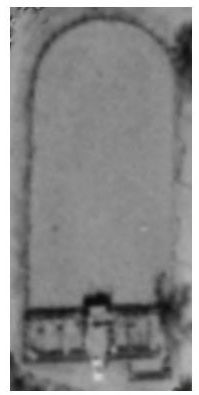 This 1963 aerial photo shows the arena and pens.
This 1963 aerial photo shows the arena and pens.
1957
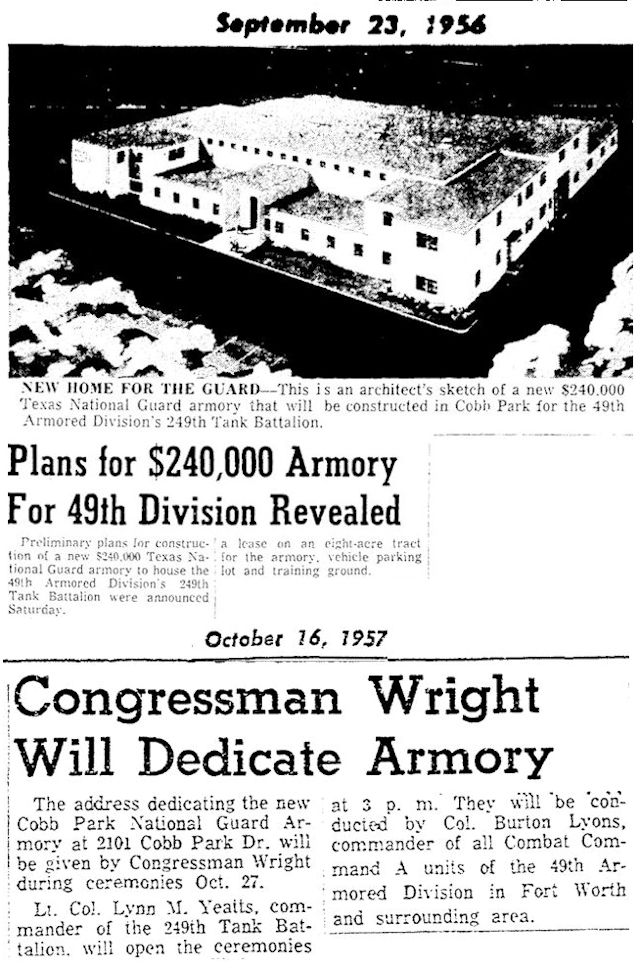 The second addition to the northern end of Cobb Park was military, not civilian, but even it helped to change the nature of the park. Tucked into the southeast corner of the northern end, in 1957 a new Texas National Guard armory housed the 249th Tank Battalion of the 49th Armored Division. But the armory was more than turrets and treads.
The second addition to the northern end of Cobb Park was military, not civilian, but even it helped to change the nature of the park. Tucked into the southeast corner of the northern end, in 1957 a new Texas National Guard armory housed the 249th Tank Battalion of the 49th Armored Division. But the armory was more than turrets and treads.
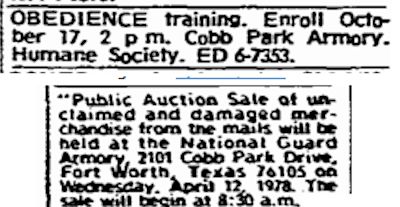 The armory was accessible by the public for open houses, postal service auctions, self-improvement classes, boxing tournaments, cat shows, and dog obedience classes.
The armory was accessible by the public for open houses, postal service auctions, self-improvement classes, boxing tournaments, cat shows, and dog obedience classes.
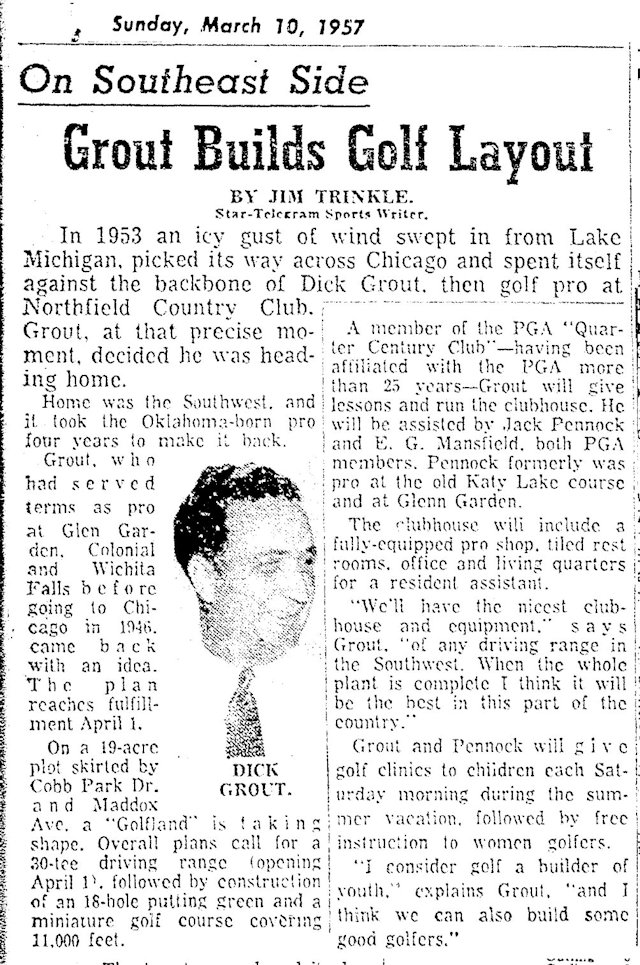 The third addition also came in 1957. Just north of the new armory Golfland opened, offering miniature golf and a driving range. The original concessionaire was professional golfer Dick Grout. He was the older brother of James Grout, who was the mentor of Jack Nicklaus.
The third addition also came in 1957. Just north of the new armory Golfland opened, offering miniature golf and a driving range. The original concessionaire was professional golfer Dick Grout. He was the older brother of James Grout, who was the mentor of Jack Nicklaus.
 The Grout brothers had been pros at nearby Glen Garden Country Club when amateurs Ben Hogan and Byron Nelson played at Glen Garden (and at Katy Lake). Dick Grout became the Glen Garden pro in 1929.
The Grout brothers had been pros at nearby Glen Garden Country Club when amateurs Ben Hogan and Byron Nelson played at Glen Garden (and at Katy Lake). Dick Grout became the Glen Garden pro in 1929.
1958
 The fourth and final addition to the northern end of Cobb Park was perhaps the most impressive. Del Murray Field was a showcase Little League park. It had a scoreboard, cinder-block concession stand, public address system over which an announcer provided play-by-play commentary. Between innings the PA system broadcast Big Band songs (“String of Pearls,” “Tuxedo Junction”). Those were the songs of the adults who built and operated Del Murray Field for the kids: men and women who volunteered to coach the teams, maintain the field, operate the concession stand.
The fourth and final addition to the northern end of Cobb Park was perhaps the most impressive. Del Murray Field was a showcase Little League park. It had a scoreboard, cinder-block concession stand, public address system over which an announcer provided play-by-play commentary. Between innings the PA system broadcast Big Band songs (“String of Pearls,” “Tuxedo Junction”). Those were the songs of the adults who built and operated Del Murray Field for the kids: men and women who volunteered to coach the teams, maintain the field, operate the concession stand.
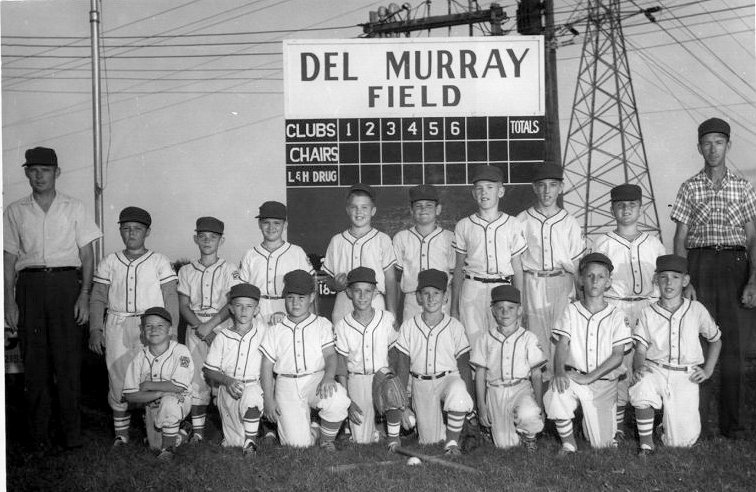 Del Murray Field had real umpires, real coaches, real uniforms, real team sponsors (such as House of Chairs, Empire Electric, Rox-Ex Exterminating, A. Brandt Furniture, and L&H Drugstore), real in-ground dugouts, real anchored bases, real lime on the base paths, real bleachers full of real parents and real friends. Everything was so real it was unreal. To boys accustomed to playing ragtag baseball on vacant lots in their neighborhoods using cracked bats and taped-up baseballs from Mott’s and running between rocks or boxes as bases, Del Murray Field was truly a field of dreams.
Del Murray Field had real umpires, real coaches, real uniforms, real team sponsors (such as House of Chairs, Empire Electric, Rox-Ex Exterminating, A. Brandt Furniture, and L&H Drugstore), real in-ground dugouts, real anchored bases, real lime on the base paths, real bleachers full of real parents and real friends. Everything was so real it was unreal. To boys accustomed to playing ragtag baseball on vacant lots in their neighborhoods using cracked bats and taped-up baseballs from Mott’s and running between rocks or boxes as bases, Del Murray Field was truly a field of dreams.
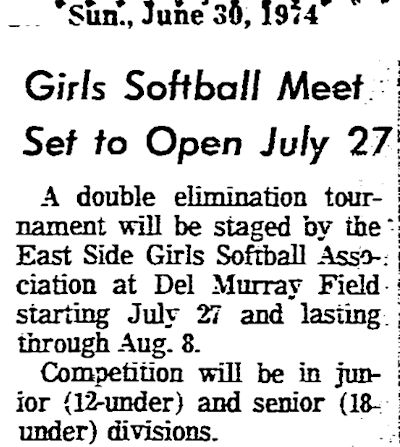 By 1974 Del Murray Field was co-ed. The East Side Girls Softball Association played there.
By 1974 Del Murray Field was co-ed. The East Side Girls Softball Association played there.
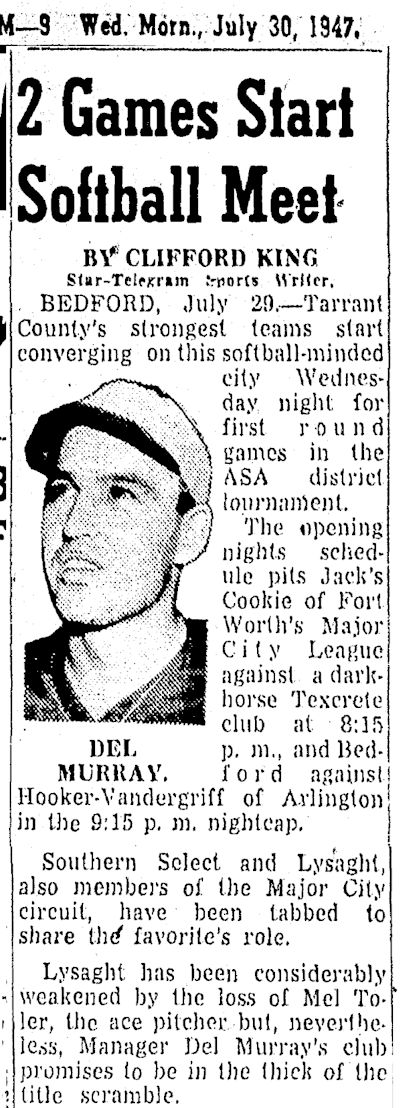 “But who,” you no doubt have often wondered, “was Del Murray?”
“But who,” you no doubt have often wondered, “was Del Murray?”
Delmer Watson Murray, who owned a service station on Rosedale at Binkley, was a longtime local amateur athlete. He played softball and coached both men’s and women’s softball teams. He also was president of East Side Little League, which built the field and named it for him after he died in 1956.
By 1959 the northern end of Cobb Park had been transformed, and, by extension, the entire park was transformed. Cobb Park was in its prime as more people than ever used the park as they rode horses, played golf, played or watched baseball, and attended auctions, boxing tournaments, or cat shows at the armory.
By 1964 U.S. 287 (Poly Freeway/Martin Luther King Jr. Freeway) had been built over the middle of the park, symbolically dividing the park into the small developed northern end and the large undeveloped southern end.
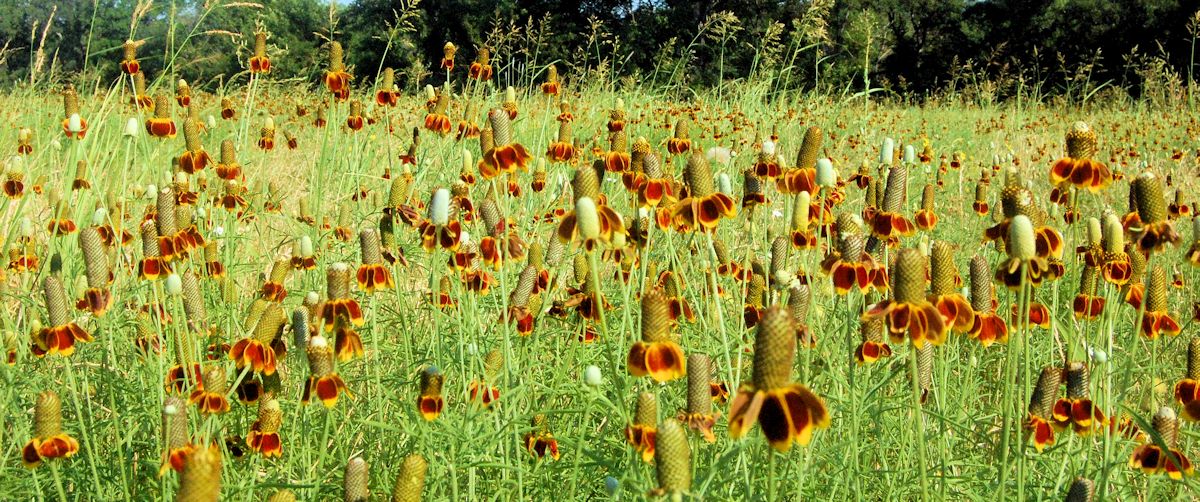 But the northern end of Cobb Park flourished for only about a quarter-century. By the late 1970s Del Murray Field was gone. Our field of dreams of the 1960s today is a field of wildflowers. The dugouts long ago were filled in, the pitching mound leveled. This is the view toward home plate from centerfield, where I spent many an inning praying that nothing would be hit my way.
But the northern end of Cobb Park flourished for only about a quarter-century. By the late 1970s Del Murray Field was gone. Our field of dreams of the 1960s today is a field of wildflowers. The dugouts long ago were filled in, the pitching mound leveled. This is the view toward home plate from centerfield, where I spent many an inning praying that nothing would be hit my way.
 Also by the late 1970s Golfland was gone, its miniature golf course and driving range and clubhouse replaced by acres of grass, as if Golfland had never existed. But wait! See that round green patch labeled “G”?
Also by the late 1970s Golfland was gone, its miniature golf course and driving range and clubhouse replaced by acres of grass, as if Golfland had never existed. But wait! See that round green patch labeled “G”?
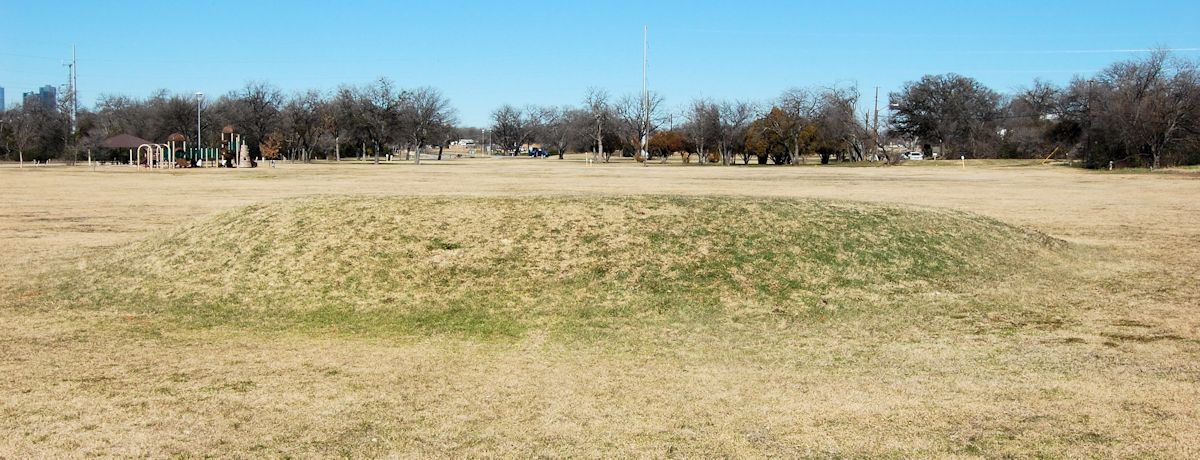 What will future archeologists make of this green mound rising from the plain of the former Golfland driving range? Was it perhaps the religious, ceremonial, or burial site of an ancient culture?
What will future archeologists make of this green mound rising from the plain of the former Golfland driving range? Was it perhaps the religious, ceremonial, or burial site of an ancient culture?
Sorta.
My friend Ramiro Garza worked at Golfland and interpreted that mound for me:
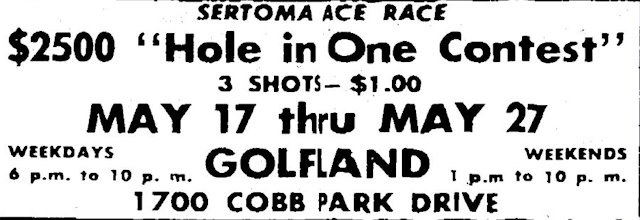 “That mound was a ‘green’ especially made for people to pay a dollar for three chances to get a hole-in-one and win prizes/money. Closest to the hole won lesser prizes, of course. Volunteers for SERTOMA (SERvice TO MAnkind) would staff it at night on the weekends to raise money. The mound was tilted so the participants could see for themselves how close they came. On a flat green it is hard to tell from a distance. A guy would actually take a tape measure from the hole to the ball. Closest to the hole won the big prize for the night, of course. I used to rest on that mound and look up at the stars late at night, a break from gathering up the night’s golf balls at fifty cents or a dollar a bucket.”
“That mound was a ‘green’ especially made for people to pay a dollar for three chances to get a hole-in-one and win prizes/money. Closest to the hole won lesser prizes, of course. Volunteers for SERTOMA (SERvice TO MAnkind) would staff it at night on the weekends to raise money. The mound was tilted so the participants could see for themselves how close they came. On a flat green it is hard to tell from a distance. A guy would actually take a tape measure from the hole to the ball. Closest to the hole won the big prize for the night, of course. I used to rest on that mound and look up at the stars late at night, a break from gathering up the night’s golf balls at fifty cents or a dollar a bucket.”
($2,500 in 1962 would be $19,000 today.)
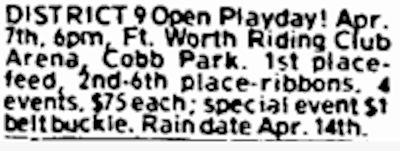 Across Cobb Park Drive from Golfland, the riding arena (in its final years doing business as “Fort Worth Riding Club Arena”) apparently closed about 1980.
Across Cobb Park Drive from Golfland, the riding arena (in its final years doing business as “Fort Worth Riding Club Arena”) apparently closed about 1980.
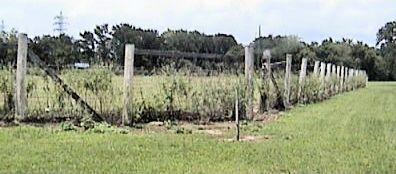 The arena fence was still standing in 2003.
The arena fence was still standing in 2003.
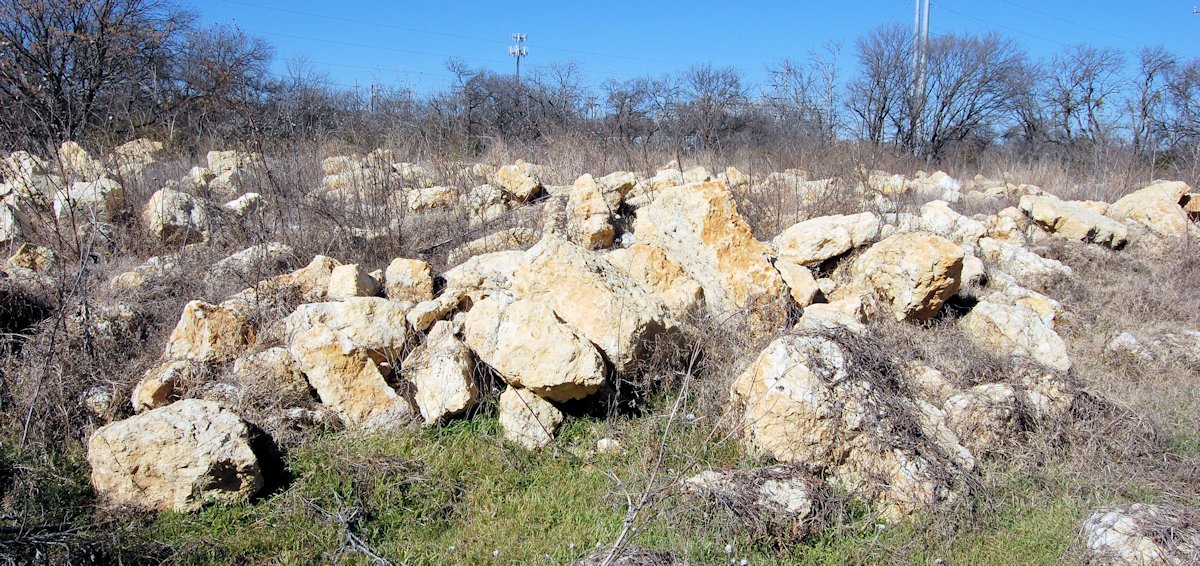 Standing on the site today you can’t see much. The city uses the site to store landscape materials.
Standing on the site today you can’t see much. The city uses the site to store landscape materials.
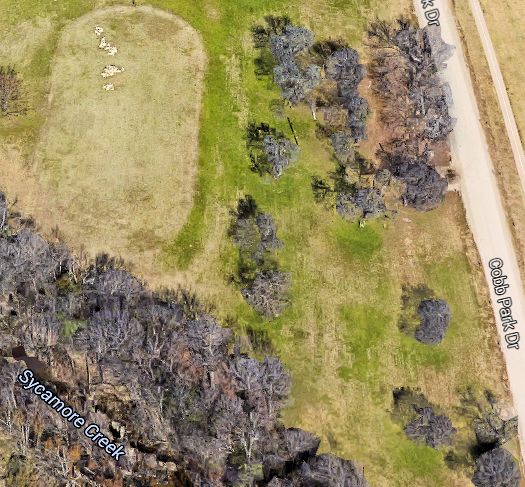
But a recent aerial photo clearly shows the footprint of the arena.
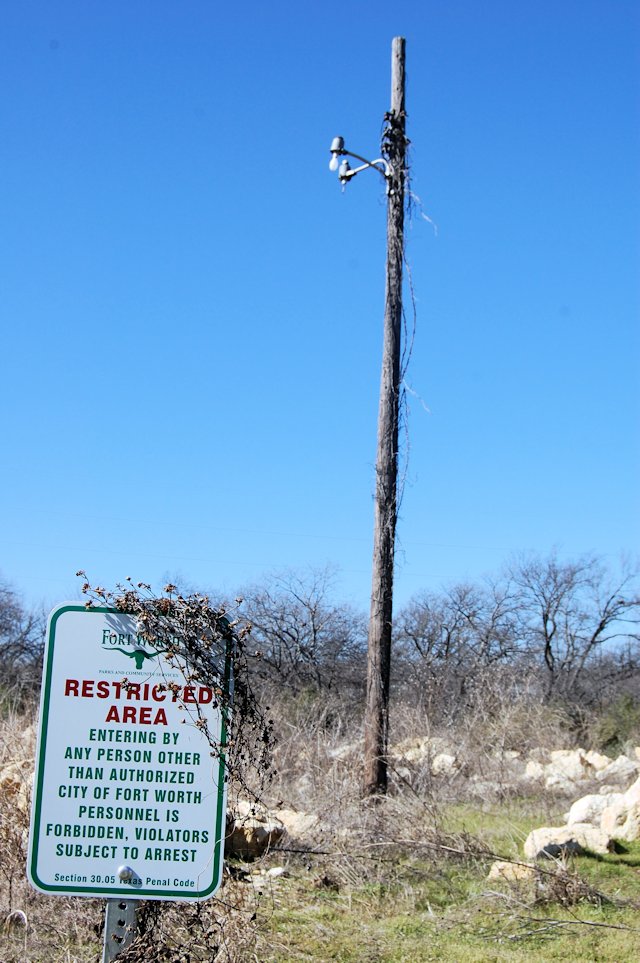 This light pole is the only relic of the arena.
This light pole is the only relic of the arena.
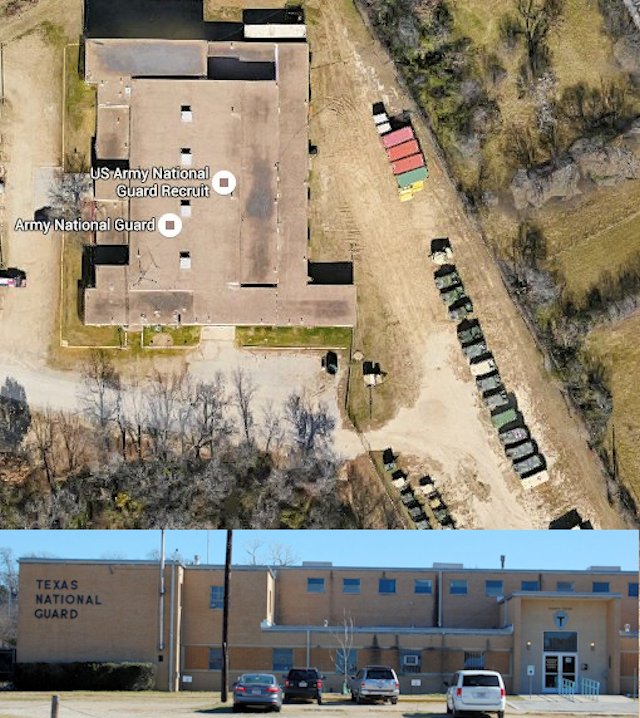 Of the four additions to the northern end of Cobb Park in the 1950s only the National Guard armory survives.
Of the four additions to the northern end of Cobb Park in the 1950s only the National Guard armory survives.
 Left: Belle Burchill (1847-1937) was postmistress of Fort Worth in the 1880s and was a founder of the Fort Worth Benevolent Home. She and her daughter Edna developed the Burchill Addition east of Cobb Park. Belle lived on Burchill Road, which is adjacent to the park. Right: Major General Albert Sidney Johnson was a namesake of Confederate General Albert Sidney Johnston.
Left: Belle Burchill (1847-1937) was postmistress of Fort Worth in the 1880s and was a founder of the Fort Worth Benevolent Home. She and her daughter Edna developed the Burchill Addition east of Cobb Park. Belle lived on Burchill Road, which is adjacent to the park. Right: Major General Albert Sidney Johnson was a namesake of Confederate General Albert Sidney Johnston.
 Today the armory is home of the 3rd Battalion, 144th Infantry Regiment (4th Texas) of the 36th Infantry Division and, as such, imbues Cobb Park with a history older than even the park itself. The 36th Infantry Division was organized in 1917 from National Guard units of Oklahoma and Texas and trained at Camp Bowie for deployment in World War I. The division’s “T-patch” emblem, an arrowhead bearing the letter T, represents Oklahoma (formerly “Indian Territory”) and Texas.
Today the armory is home of the 3rd Battalion, 144th Infantry Regiment (4th Texas) of the 36th Infantry Division and, as such, imbues Cobb Park with a history older than even the park itself. The 36th Infantry Division was organized in 1917 from National Guard units of Oklahoma and Texas and trained at Camp Bowie for deployment in World War I. The division’s “T-patch” emblem, an arrowhead bearing the letter T, represents Oklahoma (formerly “Indian Territory”) and Texas.
Cowtown Yoostabes, Sycamore Edition: Movies, Mobsters, and the Marlboro Monkey
Cowtown at Play






I came across this from searching the history of Golfland after finding an old scorecard that belonged to my dad. Imagine my shock when I zoomed in on the baseball team picture and I see my dad in the bottom right corner! And although I didn’t see a lot of pictures of my uncle from when he was that age, I think he’s in there too. Thanks for putting this up and making my night!
So it has come to this–I have been contacted by a CHILD of a boy I played ball with as a child! How can that be?! LOL. But seriously, I happen to have the ID for that photo:
Top row from left, coach Rhodes (father of Randy and Ronnie) Ricky Poteet Ronnie Rhodes Mike Overstreet Ed Campau Andy Donnelly Weldon Allsbrook Mike Nichols Guy Morrison manager Patterson (father of Randy)
Bottom row from left, Randy Russell Randy Patterson Bill Martin Ronnie Johnson Bill Russell Randy Rhodes Gerry Harris Paul Allsbrook
Because the maximum age for Little League was twelve, Weldon and I probably were twelve–about 1961. House of Chairs was the team sponsor, had a tiny store on East Rosedale. Playing East Side Little League and Pony League at those great ball fields with those great coaches and kids was a highlight of my youth. Thanks for helping me remember, Brady.
Interesting. You might recall from the Ed Peacock days of baseball his team (of which I was a regular contributor) practiced in an area of Cobb Park we fondly called “the Hole”. We got there from a road off South Berry near Ward’s I think. The Parks Dept graciously dragged the dirt infield on a regular basis. I’m sure it too no longer exists, joining the obituaries of Del Murray Field and East Side Pony League Park.
It was good to see you at our “50th”.
And Empire Electric (Mr. Farley? Mr. Lindley?) practiced on a field just across Maddox from Del Murray near an electrical substation. All gone now. Folks would think we dreamed it. My first summer job out of Poly was working for the Parks Department out of Cobb Park. My crew dragged the baseball diamonds using a length of chain link fencing behind a flatbed truck. Good to see you again, Gary.
Great post Mike. I have been feeling younger lately, perhaps because of all the old memories. I thought you were suppose to feel older? Anyway, thanks for the shout out. I did not realize I was “on the record”.
I should have known with your journalist background, ha!
Thanks, Ramiro. Your explanation of the mystery mound was the highlight of my education about the northern end of Cobb Park. The mound and the light pole across the street are the only remnants of those three recreational facilities of long ago.
A. B. Post later moved to Shreveport where he was a prominent car dealer…and was the father of Buzz Post, former GM Pontiac dealer in Arlington, 1-20 at Cooper….Four of 5 of Post’s children live in the Northeast Tarrant County area….
Oh
my
God!
What a great connection. I remember the Post Pontiac dealership. I may add this to the post and credit you, Dan.
Great “overview”, pics, and commentary Mike. I really miss all the good times at Cobb Park, the golf range and Del Murray. For your readers that might not know you, you are the fine, tall little league athelete in the pic…back row, second from right! Haven’t changed much, eh? Nor have I! The only thing missing from your Cobb coverage that I can see is a view from you actually wading in the middle of the creek amongst those water mocassins that are unique to the park: they can’t bite when under water as I remember the story. Thank goodness lest this narrow seat bike series likely would not be possible.
Thanks, Larry. You and I spent so much time in that park that the city could have charged us rent. As I recall, we didn’t have enough sense to be afraid of anything. Great memories. And I can’t resist a challenge: I may have to add that wading photo!